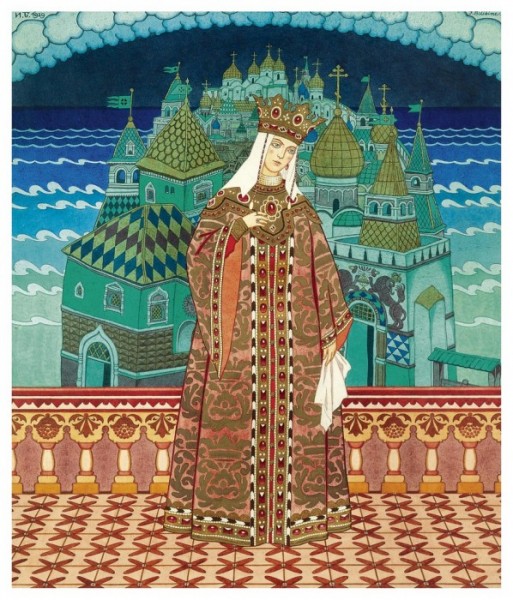
Queen – a female monarch
In not every country is the female ruler a “queen.” Throughout history, and today, women monarchs have gone by a variety of titles: Empress, Sultana, Pharaoh, Tsaritsa. Since I skipped my Thursday’s Tale yesterday, I thought I’d highlight one today, and queens are often found in folktales and fairy tales. Usually, they’re evil though, rarely good and kind, so I did a little, quick hunt and found this little story from Russia, “The Tsaritsa Harpist,” where the queen is actually the heroine of the tale. The queen is the story is, obviously, a Tsaritsa.
A Tsar and Tsaritsa lived happily in their kingdom, but the Tsar decided to go to the Holy Land, where the Accursed King was ruling. The King captured the Tsar and held him in the dungeon in chains at night and forced him to plough during the days. The Tsar sent a message to the Tsaritsa to sell all his possessions and come ransom him.
The Tsaritsa thought that if she went herself, the wicked king would take her as one of his wives, and she did not know whether she could trust her ministers to go in her place. She cut her hair, disguised herself as a boy, and set out with a gusli, a type of harp. She reached the court of the wicked king and charmed him with her music. She played for three days (of course) and the evil king promised her whatever she wished. She said she wanted a companion for her travels, so she asked for one of his prisoners. He let her choose, and she picked the Tsar. The king doesn’t seem quite that evil, does he? Perhaps he had assumed the Tsar had come to fight him, to gain wealth and glory, which mayor may not have been true. The version I read didn’t state why the Tsar went to the distant land.
The couple went back to their country without the Tsar discovering who she was. She left him before he reached his court, got to the palace first, and changed out of her disguise into a dress. When the Tsar arrived home he was angry that his wife had not ransomed him, and even more angry when he heard that she had vanished and just returned, assuming she had been unfaithful. She disguised herself as the musician again and played in the courtyard. The Tsar ran to greet the musician and introduced the guslyár as the one who had rescued him. She flung off her outer garment and everyone recognized her as the Tsaritsa. The Tsar was overjoyed and they celebrated with a feast that lasted seven days.
I’m glad that her bravery and resourcefulness was recognized in the end. I’m sure she made a good choice disguising herself. I have no doubt that the Accursed King would have taken her had he known who she was.
I read this story in Fearless Girls, Wise Women & Beloved Sisters: Heroines in Folktales from Around the World by Kathleen Ragan. In the comments on the story, she tells that history is full of women whose works of art were published under a man’s name because it was improper or impossible to publish as a woman, ” citing George Eliot and Fanny Mendelssohn whose compositions were published under her famous brother’s name. “The names of many women cannot be given a place in history next to their contributions. Their own names have been lost because they worked using men’s names.”
Thursday’s Tales is a weekly event here at Carol’s Notebook. Fairy tales, folktales, tall tales, even re-tellings, I love them all.
Thursday’s Tale: The Tsaritsa Harpist

Not impressed with the tsar, he should have trusted her
I agree!
So glad you stopped by in time to enter my giveaway, but also so I could find your blog. So many to visit! Yours’ is beautiful. (I have to say what’s wrong with those kids not wanting to go out for Icecream?!)
I love fairy tales and I love this one. Women seem to be far wiser and more courageous in the fairy tales of yore, like this one. 🙂 Happy blogging the rest of the way to Z!
Yep, three days to play the harp – that would definitely do it. Three is the magic number in these stories. Three wishes, three little pigs, three nights playing the harp!
Lynn 😀
I love these, I look forward to them each week! 🙂
This sounds good, and the Heroines in Folktales collection it comes from sounds like a great book.
Thanks to you I’m reading about another Queen. I’ll be posting about it for U. Can you guess? 🙂